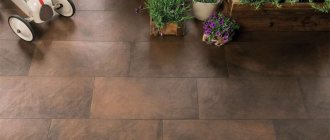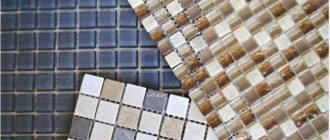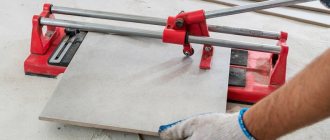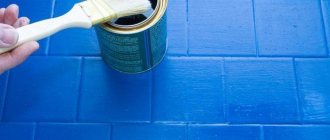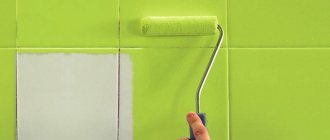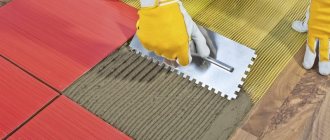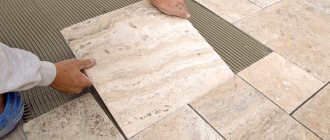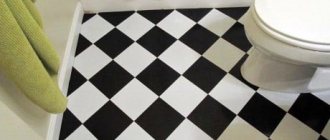The main problem when decorating a room with ceramic tiles is the lack of a special tool for cutting the material. Purchasing a high-quality tile cutter will be expensive and is not practical for home use. Therefore, many people are interested in whether it is possible to cut ceramic tiles with a glass cutter. This method is quite acceptable, but it is not suitable for all tiles. In this article, we will look at which tiles can be cut with a glass cutter, and we will also figure out how to choose the most suitable tool and perform the cut correctly.
Subtleties and tools
- It is better to use models with a thin tip rather than a diamond one; it will be easier for them to cut tiles and the cuts will be even.
- If you need to cut more than 10 units, it is worth purchasing or renting a special tile cutter.
- To ensure smooth edges after cutting, they can be carefully sanded with fine sandpaper.
- It is better not to use a glass cutter to cut porcelain stoneware; this material is thicker and stronger, which means it will be very difficult to make a neat cut.
- A glass cutter can easily and quickly cut wall tiles; for floor tiles, it is better to use special tools; this division is determined by the thickness of the coating.
- To make the cutting process easier, the tiles can be pre-soaked in clean water for several hours.
- If the intended cutting line is 1 cm or less from the edge, it is not recommended to use a glass cutter.
- Using special tongs will greatly simplify the task. They can be rented or purchased if you plan to cut a significant amount of tiles.
In order to quickly and efficiently cut ceramic tiles, you will need the following tools:
- glass cutter with a thin disc;
- pencil or marker for marking;
- metal ruler;
- a match, a small nail or a thin piece of wood.
Advantages and disadvantages of a glass cutter
The undoubted advantage of cutting tiles is its financial availability, and, accordingly, the cost of tiling work in general. Manual glass cutters of roller and oil types are silent and do not create dust in the room, which is important for housing where there may be other residents besides the master. Also, hand tools are indispensable for figure cutting, in design solutions that require originality and exclusivity.
Disadvantages - for significant amounts of work, a manual glass cutter is ineffective. A separate item can be noted when cutting porcelain stoneware or ceramic floor tiles. In such cases, hand tools are used extremely rarely, since slabs made of such material have increased strength and thickness.
Summarizing what was said earlier, we come to the conclusion that it makes sense to use manual roller and diamond tools for small-scale cladding and in cases where it is not financially profitable to buy a more expensive professional tool - an angle grinder or a tile cutter - for one-time cutting.
Types of glass cutters
Glass cutters are manual machines. Depending on the type of working part, they are presented in the following varieties:
- Pobeditovy . A stationary cutter made of tungsten carbide and cobalt is used as a cutting element. The tool quickly becomes dull during the cutting process and creates a groove of uneven depth.
- Roller . The movable cutter is a wheel with a diameter of 5 mm made of hardened steel or a chemical compound of carbon and tungsten. The number of rollers can reach 6 pieces. The V-shaped section of the teeth ensures a uniform stroke. In this case, a trace remains uniform in depth. In some models, the working part is removable and can be replaced with a new one.
- Oily . Outwardly similar to a roller, but differs in design. A container of lubricating fluid passes through the handle of the tool. The metal head is equipped with a screw to regulate the supply of lubricant. The liquid entering the groove reduces the friction force and helps create a cut of the same depth.
- Diamond . A soldered crystal is used as a cutter. The design of modern models allows you to change the position of the diamond using a screw. This increases the service life of the cutter. Glass cutters are produced in two modifications: amateur ones with artificial crystal; professional with multi-faceted sharpening and natural diamond, with their help you can cut material of greater thickness.
The most durable models will be those with tungsten carbide rollers; steel ones wear out the fastest.
When working with tiles, a tool of any kind presses a shallow groove on the surface along which the element is broken.
Features of the electric tile cutter
An electric tile cutter is much more convenient and does its job faster.
And his cut is just perfect. They can cut shaped elements and complex angles. With such a tool you will finish the job 2-3 times faster. And of course, you shouldn’t forget about the defects, so, the waste of an electric tile cutter is also 2 times lower. The operation of an electric tile cutter is quite noisy and dirty, because... the disk is cooled by water
When working with such a tool, you need to be extremely careful; you need to properly protect your hands and eyes.
The process itself is quite simple and requires mostly little skill.
- Mark the cutting line on the tile.
- Align the cut line on the tile with the pointer on the tool (guide).
- gently pushing the tile forward to cut it
- All irregularities need to be sanded with sandpaper or a sharpening disc, which is much faster.
Quite often, at the end of the cut, the tile goes away and a small edge becomes uneven; in this case, the tile is turned over and the cut is leveled
To cut tiles in shapes you need to get used to it. Therefore, if you are working with a tile cutter for the first time, then it is better not to take on such work. Although the process itself is not considered difficult, it does have some nuances.
What is the best glass cutter to cut tiles?
Glass cutters are used for cutting glazed tiles, since their top layer is identical in structure to glass.
Pobedite instrument is the least desirable option. On a ceramic surface, his cutter becomes dull almost immediately. The cut contains chips and irregularities. The only advantage of the tool is its low price.
Roller blades are widely used and make it easier to cut tiles, while the cut is performed smoothly. Good models: Pro, 3-roller, with anti-corrosion coating (Russia), Course 16901 - 6 rollers.
The process of cutting with oil tools is similar to mechanized stone processing. The quality of the cut is better than when using roller glass cutters. The soft stroke of the cutter creates uniform pressure on the tile. Tiles break more easily. The most popular models are ENKOR and Zubr (Russia), Bohle Silberschnitt 5000 (Germany).
Special substances can be used as lubricants: Acecut 5503, Milli M2000, Novacan Cutter Oil and T-3133. These compositions have low viscosity, do not spread over the surface and evaporate easily. With proper use, the service life of the tool increases and the quality of work increases.
Note! Instead of special liquids, cheaper options are quite suitable: turpentine, spindle or vaseline oil, kerosene, white spirit.
Cutting tiles with a glass cutter with a diamond head will be the easiest and most efficient way. Corundum has the highest degree of hardness among minerals.
A diamond is rigidly mounted into the head of the part. In modern models, it is not soldered into the holder, but is mounted on a part that is attached with a screw to the head in a groove. The position of the crystal can be changed if it becomes dull. The use of a diamond glass cutter ensures that there are no chips on the cut line. The groove is thin and the fracture is smooth. To work with a professional type of tool, skills are required. Popular models: Brigadier Extrema, Sparta 872405, FIT 16930 (China), Bison expert 3362 (Russia).
Advantages of tiles
Tile has many advantages - it does not burn, does not emit toxic substances, it is resistant to temperature changes and chemicals, and does not conduct electricity.
Quite often, tiles are used for interior and exterior decoration of premises. This is due to the fact that it is a highly durable material. Properly installed tiles can withstand pressures of approximately 30,000 t/m², making them even stronger than reinforced concrete. Consequently, the tile is practically not subject to deformation. Another important advantage of tiles is that they are hygienic, easy to care for, dirt can be easily removed from them, and their surface does not promote the development of bacteria. The tiles are not afraid of moisture. That is why it is often used to decorate bathrooms, showers, and toilets.
Tile does not ignite, does not emit toxic substances when heated, and is not subject to destruction upon contact with highly toxic chemical elements. The tiles are resistant to different weather conditions - snow, rain, direct sunlight - this makes the tiles a wonderful material for exterior decoration. A particularly significant advantage is that it does not conduct electric current, so its use is safe in any conditions.
Related article: Using a needle roller for installing self-leveling floors
The disadvantage of tiles, perhaps, is their high thermal conductivity, making them cold upon contact. The tiled floor is unpleasant to walk on bare feet. However, this drawback is easily corrected by combining tiles with heated floors.
All of the above properties of tiles are inherent in them only if they are installed correctly.
Features of cutting with a glass cutter
Cutting process
Don't miss: Laying tiles in corners: features and joining methods
Of course, you don’t have to use a glass cutter to cut tiles; the following tools can help you:
- Manual tile cutter
- Electric tile cutter
- Bulgarian
- Wire cutters
But what to do if you have nothing but the aforementioned glass cutter?
Then we'll cut them!
Important! You need to understand that you definitely won’t be able to cut 5 mm from a tile using a glass cutter. At some point, you will be taking the tile for a “break,” and this is difficult to do when you only need to separate 5 mm or less.
Next, in general, you first need to figure out whether your tiles can be cut with a glass cutter. Previously, this was no problem, but now manufacturers produce so many ceramic tiles that it will be difficult to cut even with a manual tile cutter, and what can we say about a glass cutter! Therefore, it would be a good idea to practice on broken tiles - in general, will the tool you choose take your tiles?
A few secrets
If you need to cut tiles along a curved line or into thin strips, special pliers are used.
In cases where it is necessary to cut thin tile strips, you can use special nippers or pliers that need to be broken off in small pieces. In stores you can find cutters designed for cutting ceramic tiles. It combines a glass cutter and wire cutters at the same time. If you choose a cutter, you need to take it with a replaceable wheel or with a diamond glass cutter.
It is convenient to use a glass cutter for one-time household work; for a large scale of work and if great accuracy is required, you need to use other cutting methods, for example, a tile cutter. It works on the same principle as a glass cutter, only it has a larger cutting roller. A tile cutter is a hand tool whose operating principle is similar to that of a glass cutter. The difference is that the tile cutter has restrictions on the thickness of the material being cut. First, the enamel is cut with a cutter, and then the tile is broken along the line. A tile cutter is a plier-like tile clamp with a glass cutter built into it.
A glass cutter is a more versatile tool compared to a tile cutter, but both of them are only suitable for home use.
Preparing for work
Before you start cutting tiles, you need to prepare for the job. In addition to the cutting process itself, you need to clarify some points about the work.
Selecting a glass cutter
Types of glass cutters
If you decide on a glass cutter as the main tool for cutting ceramic tiles, then you can choose three models:
- Roller type glass cutter;
- Oil type glass cutter;
- Glass cutter with diamond tip.
Of course, the simplest and easiest to use is a roller type glass cutter. A small roller (also called a roller) as a cutting tool provides a thin cutting line without chipping along the edges. An oil-type glass cutter is a good alternative, the operating principle of which is the same as that of a roller cutter.
Only it is equipped with an automatic supply of liquid-oil to the cutting mechanism. The oil is located in the cylinder of the pen shaft and provides lubrication during cutting, which greatly facilitates the work. Both of these models of roller glass cutter do not require special training; a beginner can easily handle them.
A diamond glass cutter requires an “experienced” hand. Only a specialist who knows firsthand how to use it and has “accustomed” to a diamond cutter can cut ceramic tiles with such a tool. Otherwise, a lot of tile material will be damaged.
Don't worry if the cut edges don't immediately turn out as sharp as you want. Uneven cut depth may depend not only on lack of experience and incompetence in using the cutting tool, but also on the poor quality of the ceramic material itself.
In such a situation, the situation will be corrected by sanding paper (sandpaper) with medium or coarse grain, thanks to which the ends of the cuts are rubbed, resulting in a perfectly smooth edge.
Additional tools
To cut tiles/tiles in a high-quality manner, you need the following set of tools:
- The glass cutter itself (roller, diamond or with automatic oil supply);
- A marker for drawing a cutting line, preferably water-based, so that the marking can be easily removed without leaving marks.
- A metal square or ruler that is used for measuring and as a guide when cutting tiles/tiles;
- Table with a stable horizontal surface;
- A wooden block (pencil) for lining the fracture site;
- Paper for sanding medium and coarse fractions;
- Protective gloves;
The nuances of cutting tiles with a glass cutter, advantages and disadvantages
Special mechanical tools and electrical devices are much more convenient for cutting ceramic products than a glass cutter. But such special devices are much more expensive. Therefore, if cutting tiles is carried out at home with small amounts of work, it is more practical to use a glass cutter. After all, it is completely inappropriate to use expensive tools when you only need to trim a few tiles.
The glass cutter has some advantages over other devices for cutting tiles:
- affordable price;
- ease of use.
But using a glass cutter also has significant disadvantages:
- it is not suitable for large volumes of work;
- the tool is not able to cut through dense tiles;
- there is a possibility of damaging the tiles.
Using such a tool is not very convenient. The glass cutter has a small roller that makes shallow grooves. Therefore, you have to break the tiles manually, which creates the risk of the tiles cracking or breaking unevenly. Due to such sequential procedures of marking, notching and breaking, the entire process of cutting a clay plate is quite long and tedious. Therefore, it is not recommended to use a glass cutter for large volumes of work.
Even the glass cutter, with its small roller, is not capable of cutting through heavy-duty porcelain stoneware. It is also unlikely to scratch thick floor tiles to the depth required for breaking. The tool is only capable of cutting thin wall tiles. Therefore, for large volumes of work or cutting powerful products, it is better to purchase a special tile cutter.
Don't miss: Non-woven wallpaper - don't be afraid of them!
Safety precautions
Before you start finishing work and, in particular, cutting tiles, you need to take care of your workplace.
The table or any other surface must be well secured.
Check work tools and necessary equipment.
If the room is not well lit, it is necessary to use portable lamps powered by 12-42 V sockets. Pay attention to cleanliness in the workplace - excess tools and construction debris lying underfoot can lead to injury.
According to safety standards, the employee must be provided with special clothing and personal protective equipment. More details about this:
- Suit made of thick fabric - protects the body from possible cuts and injuries when working with cutting tools;
- Glasses – protect your eyes from debris and dust particles. The glass in them must be made of plastic or unbreakable material;
- Respirator - protects the respiratory system from dust that is formed when cutting tile material. This protection is used when there is a large volume of work.
- Gloves – protect your fingers from cuts on the sharp edges of the tiles. In some cases, rubberized ones are used if the surface of the tile material is glossy or has been degreased.
When doing work cutting tile material, you need to be extremely collected and attentive, use the work surface, and not break the tile along the cut line by weight or on your knee.
Compliance with safety regulations, the use of special clothing and personal protective equipment makes it possible to cut tile material without injury and with maximum efficiency.
Other methods of cutting tiles
Using a glass cutter is not the only way to cut tiles. You can use a whole series of tools that can handle the processing.
Bulgarian
The angle grinder is suitable for both straight and complex cutting of tiles. It can give tiles a specific silhouette, make oval, round and rectangular cuts, and cut at an angle of 45°. The best attachments for processing tiles are diamond-coated steel discs, combination wheels, segmented and solid dry cutters.
But first you need to study the markings of the disc and make sure that it is suitable for working with this type of ceramic. Due to their design features, solid dry cutters require thermal unloading - cooling with water. And they can work continuously for no longer than 15 seconds.
Segmented models are a better option; moreover, they can be used to cut thick tiles – floor tiles and porcelain tiles.
Drill
A drill and a hammer drill are suitable not only for cutting ceramics, but for making holes of different diameters and shapes. The main thing in working with this device is choosing the correct nozzle in terms of configuration and diameter:
- “ballerina”;
- full-bodied with notches;
- in the shape of a peak;
- cylindrical;
- crowns for drilling holes for wiring communications.
All nozzles must be made of carbide metal and coated with a layer of diamond coating. The most convenient way is to get a set of attachments for different tasks.
After securing the nozzle to the body, check that there is no play and begin drilling at the intended point. On a glazed surface, the nozzle may slide; masking tape glued to the smooth side will help increase the friction force.
Hacksaw
A hacksaw is an alternative option for cutting tiles with a glass cutter. Sawing is carried out only with carbide blades or coated strings.
Budget accessories for a hacksaw are suitable only in cases where you need to cut a small amount of tile.
Marking and preparation are carried out according to the standard algorithm - soak the tiles in water and mark the cutting lines with a marker. A unit of tile is laid on a clean, level base (countertop), leaving an overhanging part marked for the cut. The tiles are fixed by hand and a precise and even cut is made with a string.
A circular cutout for a pipe for a hacksaw is also not particularly difficult. Using a pencil, draw a circle for the tube and drill a hole in the center. A sawing string is threaded through it without a frame, and then the hacksaw is assembled into a single structure. All that remains is to saw off the intended area and remove excess segments.
Jigsaw
Electric jigsaws are equipped with a wide variety of attachments, including those suitable for cutting tiles. The edge of the nozzles is made of hard material with diamond or tungsten carbide coating, which ensures its increased strength.
How the tool works:
- Perform markings on the surface of the tile.
- Fix the nozzle and check the reliability of the connection.
- Bring the device to the tile, starting cutting strictly at a right angle. To prevent the tile or instrument from deteriorating, move carefully, without jerking, jolting or additional effort.
Tips and tricks
Before cutting tiles with a glass cutter, it is recommended to purchase a model with a thin disk instead of a diamond tip; it is much easier for them to cut and the edges remain even when broken. When working with large volumes, of course, it makes sense to rent a professional tool or purchase your own if funds allow.
It is recommended to use glass cutters with a roller
Even after cutting with a professional tool, in many cases the cut edges are unclear. This occurs due to uneven cutting depth, poor quality ceramic tiles, or insufficient experience in carrying out such work. However, the situation can be easily corrected by cleaning the edges of the cut using medium or coarse sandpaper.
If you had to work with porcelain stoneware, it is advisable not to use a glass cutter, since this material has different characteristics. These tiles are much thicker than ceramic tiles and much more durable. For an ordinary glass cutter, such material is beyond the power and it will be almost impossible to obtain high-quality cutting. The same applies to floor tiles, which differ significantly from wall tiles in terms of strength and thickness of the product.
Porcelain tiles are too tough for an ordinary glass cutter
To make work easier and significantly increase the quality of the cut when working with wall tiles, experts recommend soaking the material in plain water for 3–4 hours before cutting. Since the tile has a porous structure, water will significantly soften the product and allow you to make high-quality cuts, even if you do not have enough experience. It is important to remember that if you need to make a cut at a distance of less than 1 cm from the edge of the product, then it is not recommended to use a glass cutter, since it will not be possible to make a good chip without the proper equipment.
Nuances and recommendations of the masters
- The functionality of the tongs and the glass cutter-roller is combined with the tile cutter-tongs. It is suitable for processing the most difficult types of tiles.
- An oil tile cutter requires filling the container no more than a third full. To cut a limited number of ceramic products, simply dip the roller into a container of lubricant.
- Tiles intended for sawing must be free of dust and dirt. This will help maintain the trajectory of the glass cutter.
- If it was not possible to cut through the tile the first time, you need to return 2-3 mm from the place of separation and continue to draw the line.
- At the beginning and end of the outlined cutting line, use the glass cutter with less pressure to avoid splitting.
- Beginners should use lightweight glass cutters with wooden handles.
Using a glass cutter to cut tiles is justified at home. The method is considered acceptable only for thin wall tiles. To work with more durable materials, it would be advisable to use a power tool.
How to cut
If you know how to cut glass, then these skills will certainly come in handy when cutting tiles or ceramic tiles, since these processes are essentially the same.
They differ only in how the marking is made and what effort needs to be applied when breaking.
Cutting tiles is not difficult, but it will take some time to, as they say, “get the hang of it.” To do this, you can use scrap pieces of tile to work out or adapt to the force that will be required for a particular material. Don’t neglect the “little tricks” that every experienced craftsman has in stock. The cutting process looks like this in steps:
- Prepare your desktop. It must have a smooth and hard surface.
- Place the tile face up on the table. Using a ruler, mark the cut line with a marker. (Use a water-based marker so it can be easily removed with water).
- Place a ruler along the drawn line and run the glass cutter along the tile from the far edge of the product towards you. Use a metal ruler as a guide and try to distribute the force evenly when pressing the cutting tool. The cut is ready!
- We place a wooden block under the tile (along the cut line) and press on both sides. The tile easily splits into two halves at the cut site.
- Look along the end of the cut line. If large chips are visible, then use medium or coarse sandpaper to clean the edges of the tiles. This will give the details a finished look.
It is worth clarifying some important points:
- Do not cut the tile material in advance, but do it during installation. With this option, you will get a minimum amount of scrap tile material, since few people manage to accurately calculate the distance between the tiles in advance.
- Try to apply even pressure on the handle of the glass cutter while cutting. Remember that if you press harder, the surface of the tile will become covered with small cracks. And if you don’t apply more pressure, the breaking line will come out chipped or even break off the line.
- It is better not to use a glass cutter if you need to make a cut smaller than 1 cm. A short piece of tile can break off unevenly during the cutting process and ruin the entire tile as a whole.
- And now about the “little trick”. Experienced tilers advise soaking the tiles for 3-4 hours in plain water before cutting. After such “water procedures” the tile material becomes more plastic, and this allows for high-quality cutting.
Hand jigsaw with diamond-coated file
A hand jigsaw is convenient for making curved cuts, but to work with durable ceramics you need a diamond-coated file. This tool can be used to process both wall and floor ceramics.
Hand jigsaw with tile file.
Let's take a step-by-step look at how to cut tiles with a hand jigsaw:
Step 1. Marking.
Done with a marker on the surface.
Step 2. Fixation.
When working with a manual jigsaw, you can hold the tile product with your hand.
Step 3. Cut.
Part of the whole is sawed off in the standard way. You can pre-stick paper tape over the cut area - there will be less chipping and dust.
Step 4. Revision.
Final sanding of the edges after cutting is necessary.
Porcelain stoneware cutting technologies
Let's look at the technologies for cutting porcelain stoneware using the most popular tools.
Manual tile cutter
Despite its simplicity, a manual tile cutter provides a fairly high quality of work. The tool consists of a support platform, two guides, thanks to which the cut is perfectly smooth, a lever with a cutting roller and clamps for breaking the tiles.
The manual tile cutter is suitable for tiles with a thickness of 8 mm, 1 cm, etc. (up to 12 millimeters). Please note that the thicker the tile, the larger the cutting roller should be in diameter. Ideally, these two values should coincide.
Preparing the tile cutter for work
Before starting work, you need to make sure that the cutting roller is not dull and its size corresponds to the thickness of the selected tile. If necessary, the roller is replaced.
The ease of movement of the tile cutter along the guide rods is determined. If the cutting element passes tightly or, on the contrary, dangles, it is worth checking the bearings and cleaning the guides.
Cutting porcelain stoneware
- After taking measurements, make appropriate marks on the tile with a pencil or marker;
- the tiles are laid on the tile cutter platform, the cutting line is aligned with the cutting roller;
- so that the tile does not move during cutting, it must be fixed by hand;
- the roller is installed on the edge of the tile and, gently pressing the lever, it is drawn along the entire cut line;
The smoother you move the roller, the better the finished cut will be.
- after the cut is made on the tile, it is secured to the platform with fixing tabs so that the cut line is between them;
- They begin to press on the part of the tile protruding beyond the platform with their hand until the tile breaks.
When cutting with a manual tile cutter, the edges of the tiles are quite smooth, but the appearance of small chips and unevenness is possible. In this case, the deformed edge must be sanded.
Video: how to cut porcelain tiles with a manual tile cutter
We offer you a master class on cutting porcelain tiles with a manual tile cutter.
Bulgarian
A grinder can cut a wide variety of materials, porcelain stoneware is no exception.
Preparing for work
To cut porcelain stoneware, a special “diamond blade” must be installed on the grinder. When installing the disk, check that it is securely fastened, and be sure to wear safety glasses and gloves.
Working with an angle grinder
The technology for cutting porcelain stoneware differs little from cutting other materials.
Markings are applied to the tile with a pencil along which the cut will be made;
- The tiles are cut along the marked line with a grinder. To reduce the number of chips, try to cut the tiles “in one go”;
- Since when cutting porcelain stoneware with a grinder, small chips and cracks may remain on the edges and front side of the tile, the end of the tile after cutting is cleaned with sandpaper or a grinding disc.
Video: how to cut porcelain tiles with a grinder
Electric tile cutter
If the two previous methods are considered within the framework of “dry” cutting, then the next technology refers to “wet”. In other words, during the process, water is supplied to the tile cutter, which protects the cutting element from overheating. This ensures an almost perfectly even and smooth cut.
Electric tile cutters come in two types: with a movable and a fixed disk. In the first case, the cutting module moves along the tile along special guides, in the second, the tile is fed onto the disk using a platform or simply by hand.
In addition to the platform and cutting module, most electric tile cutters are equipped with a container of water into which part of the cutting disc is immersed. This helps protect the disk from overheating and also significantly reduces the amount of dust during operation.
Preparing for work
Before starting work, you should check the reliability of the disk fastening and the presence of water in a special container.
If the tile cutter has already been used, then the cutting disc must be cleaned and the water changed, since porcelain stoneware chips that have fallen into it interfere with the cooling process.
Tile cutting
The cutting technology itself with an electric tile cutter is very simple: a pre-designated cutting line is aligned with the cutting disk and a special lever moves it along the tile or feeds it onto the disk.
